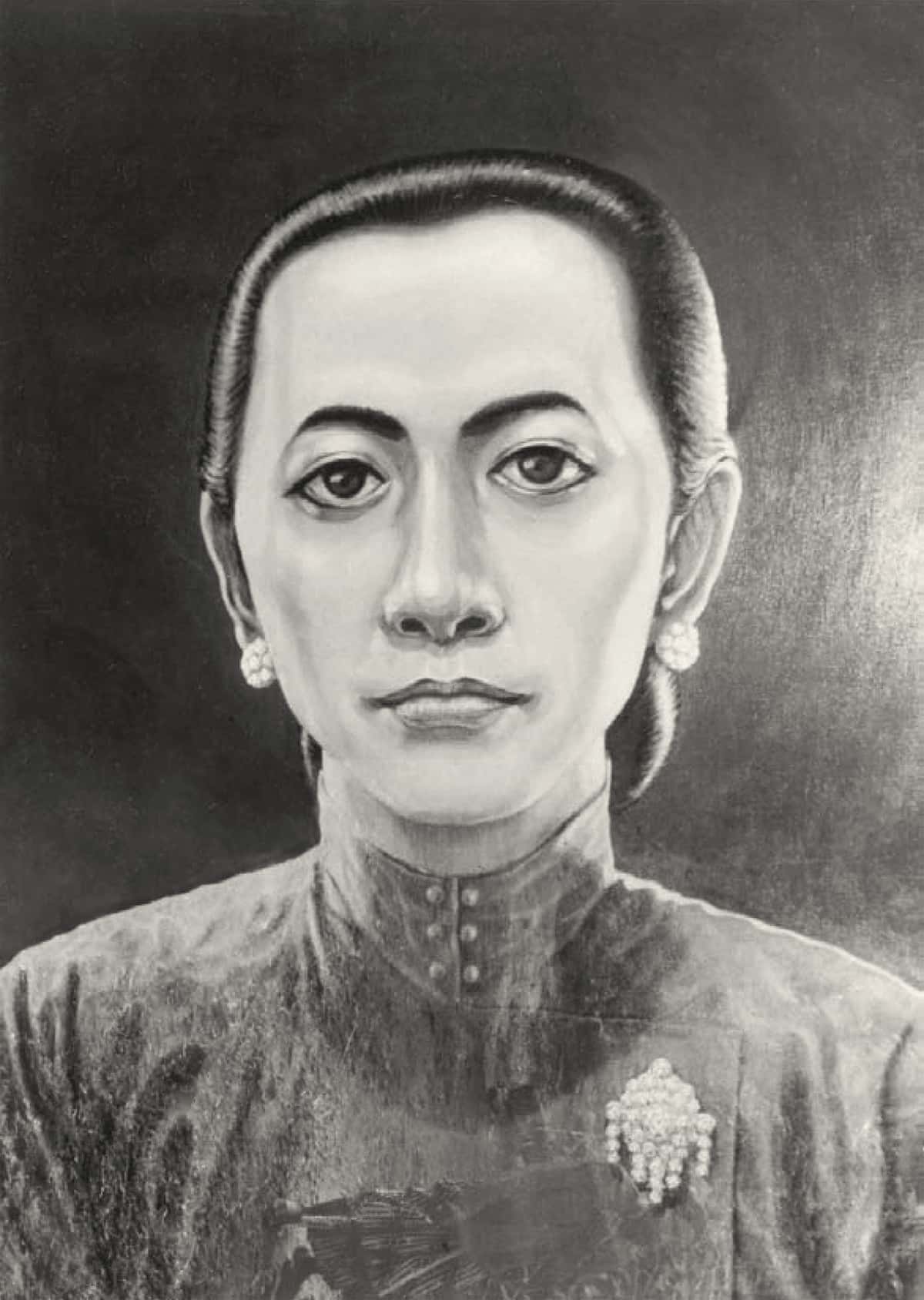EN / ID
Chapter V.
Prajurit Wanita
Ratu Ageng (ca. 1732–1803), consort of Yogyakarta’s first Sultan and guardian of Prince Diponegoro, became the first commander of the prajurit èstri (female bodyguard). Her legacy endured as many elite women later fought alongside Diponegoro during the Java War against Dutch colonial rule.

It is often difficult to find authentic cultural representations of female warriors and rulers in Southeast Asia. Yet these stories are essential for a young nation striving to shape its future with inclusivity, equality, and accountability. Narratives of powerful women offer not only role models but also critical reflections on how societies once embraced balance and shared authority. The challenge today is how to reconstruct these disappearing accounts and recover women’s roles in building enduring civilisations such as ancient Java.
—Melissa SunjayaMy impressions of Javanese women are shaped by the spirit world of Ratu Kidul, goddess of the southern ocean. Through her presence, I came to sense the potency of perempuan-perempuan perkasa—women of power whose very name, per-empuan, refers to spiritual accomplishment and empowerment. In pre-colonial Java, they were warriors, craftswomen, Sufi mystics, seers, healers, and forgers of magical keris blades. Yet much of this legacy has vanished. How has such a history of empowerment been forgotten, and how was Java’s Polynesian past so thoroughly effaced?
—Peter Carey
What is the most popular contemporary image of a Javanese woman? For many young Indonesians today, the answer is shaped less by historical heroines than by Western pop culture and mass media. Through films, novels, and social platforms, the prevailing archetype of the Javanese woman has become one of quiet obedience, beauty, and demureness—a stereotype that rewards docility over strength. This archetype, which emerged during the late nineteenth century under the influence of colonialism, suggests that dignity and femininity are defined by silence and absence.
Yet this narrow representation does not reflect the richness of Java’s past. Prince Diponegoro, the charismatic leader of the Java War (1825–1830), was born and raised in a household where powerful women played a significant role in shaping his young world. He grew up under the care and guidance of female elders who were respected not only as mothers and caregivers but also as strategists, traders, linguists, warriors and mystics. In his formative years, matriarchal and patriarchal ideals coexisted in a state of balance. Women were neither confined to the private sphere nor restricted by an innate timidity; they were deeply woven into the political, cultural, and spiritual fabric of Javanese life.
This pre-colonial reality is crucial to revisit. To dissect Diponegoro’s life through a feminist lens is to recover the history of a civilisation where the empowerment of women was neither unusual nor exceptional. It was part of the order of things: a matriarchal society inherited from the archipelago’s Polynesian past. Understanding this balance of power is also essential for interpreting Javanese belief systems, such as the enduring legend of Ratu Kidul, the goddess of the Southern Ocean.
Women of Power in Diponegoro’s World
Diponegoro’s great-grandmother, Ratu Ageng, embodied this legacy. A consort of the first Sultan of Yogyakarta, she was not a passive royal spouse but initially a military leader. She oversaw the prajurit èstri—female warriors trained in combat, horsemanship, and the handling of cavalry carbines—who defended the inner palace (kadaton) at night. Ratu Ageng’s discipline and spiritual strength left a deep impression on her great-grandson. She embodied the qualities of both nurturer and commander, passing on the conviction that women could hold military and political authority.
During the Java War, Diponegoro’s female allies were not ornamental extras but decisive strategists. Among them was Raden Ayu Serang, better known as Nyi Ageng Serang, a descendant of the famous Islamic wali. who spread Islam in south-central Java, Sunan Kalijaga. Feared by the Dutch for her battlefield prowess and respected by Javanese followers for her insights as a mystic, she commanded troops with extraordinary skill. In early September 1825, she orchestrated a night attack that destroyed a Dutch column of 250 soldiers, leaving more than half dead. Her leadership was so formidable that Dutch reports described her as “a clever but much-dreaded woman who excelled in acts of cruelty”. Today, she is remembered as a National Hero.
These were not isolated figures. Archival records indicate that women in Java played active roles in trade, diplomacy, religious life, and court politics until the early nineteenth century. Their strength was not only tolerated but institutionalised. Corps of female guards existed in Yogyakarta, Surakarta, and Mangkunegaran, embodying the recognition of women as protectors and warriors.

Feminine Divinity and Sacred Authority
The empowerment of Javanese women cannot be separated from the cosmological order. Myths of goddesses—Durga, Uma, and above all Ratu Kidul—illuminate the sacred dimension of female authority. Ratu Kidul, consort of kings since the founding of the Mataram dynasty, was seen as both destroyer and nurturer, death-bringer and fertility goddess. Her rituals in the palaces of Yogyakarta and Surakarta reinforced the idea that feminine power underpinned the legitimacy of rulers.
Sacred dances like the Bedoyo Ketawang invoked her presence through the bodies of nine high-born women. In these ceremonies, female dancers were not passive performers but living vessels for divine power. The mythic union of ruler and goddess reminded all that political authority was inseparable from feminine spiritual potency. For both Diponegoro and Nyi Ageng Serang, meditations in caves along the southern coast deepened their connection with this sacred feminine divinity, which guided them during the Java War.
Colonial Disruptions
How, then, did this balance erode so rapidly? The turning point came with colonial conquest. In 1812, when Raffles imposed treaties on south-central Javanese courts, rulers were forbidden to maintain standing armies. Female bodyguards, who had fought bravely during the British attack on Yogyakarta that year, were disbanded. Although some of these women later served in Diponegoro’s armies, their institutional base was broken.
At the same time, Dutch colonial culture introduced new stereotypes. Late nineteenth-century novels by European writers such as Louis Couperus propagated the myth of the “gentle Javanese” and the “demure” regent’s wife in his famous novel De stille kracht (‘The Hidden Force’, 1900)—images of quiet, obedient femininity that bore little resemblance to the formidable queens, warriors, and female mystics of Java’s past. These orientalist narratives exoticised Javanese women as sensual and submissive, erasing their historical agency.
By the late colonial period, women’s roles were confined largely to the domestic sphere. Figures like Kartini and Dewi Sartika, who campaigned for education and reform, emerged from a context where female agency had been systematically curtailed. Unlike the noblewomen who surrounded Diponegoro, they lived in a world where access to politics, military life, and intellectual leadership was systematically denied.
Recovering a Lost Balance
The pre-colonial history of Javanese women challenges us to rethink Southeast Asian feminism. Often framed as a modern, imported ideology, feminism has deep roots in the archipelago. The balance of male and female powers—evident in politics, belief systems, and social structures—was part of Javanese civilization long before European colonialism. The problem is not that feminism was absent, but it was deliberately erased.
Today, young women are still being asked, “When will you marry?” or “When will you have children?”, but it is vital to remember that these expectations are not timeless traditions. They are the legacy of colonial constructs that intentionally diminish women’s roles. Pre-colonial Java shows us that gender roles can be quite otherwise—that women can be warriors, strategists, mystics, and rulers without compromising their dignity as females.
As Yuval Noah Harari reminds us, the best reason to learn history is not to predict the future but to free ourselves from the past and imagine alternative destinies. Decolonising our understanding of gender requires recovering the memory of these powerful women and reasserting their rightful place in our histories.
By revisiting Diponegoro’s life through a feminist perspective, we see not just the heroism of a prince, but the extraordinary women who shaped his world. They remind us that the balance of power between men and women is not a utopian dream, but a reality that existed in Java a mere two centuries ago and is eminently revivable.


